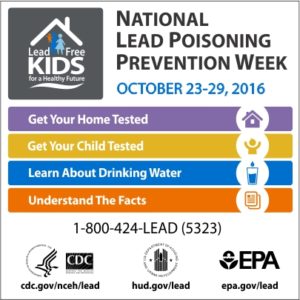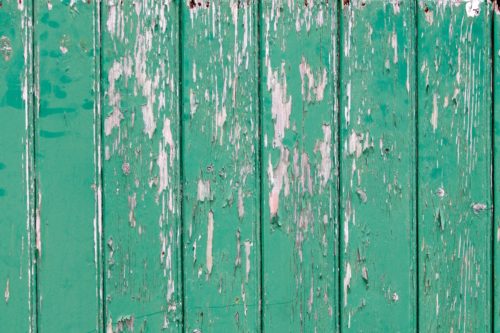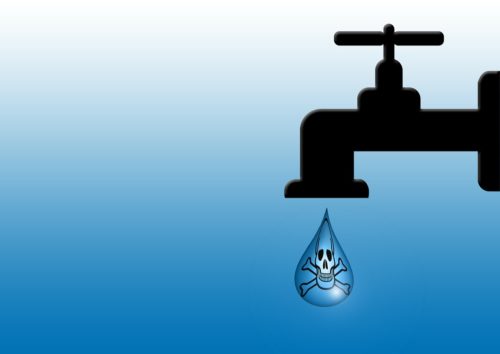
(Provided by EPA.)
This week, October 23 to 29, 2016, is Lead Poisoning Prevention Week. I had actually thought this was a problem of the past with the elimination of lead in paint and gasoline. Unfortunately, this is not true. The problem of lead poisoning is still very much present.
Statistics on blood lead levels (BLL) in children under age 6 have been compiled by the Center for Disease Control and Prevention since 1995. In 2015, there were approximately 500,000 children ages 1 to 5 with BLL greater than 5 mcg/dL (the level at which public health officials become involved). The significant adult exposure limit is 10 mcg/dL.
In reality, there is no known safe level of lead exposure.
And unfortunately, the method of this data collection makes it impossible to compare levels between states, counties, etc.
Dr. Jean Dodd’s Pet Health Resource Blog indicates that the BLL considered toxic in dogs varies by source. The Clinical Veterinary Advisor gives a range of 10 to 35 mcg/dL as significant exposure, with toxic level greater than 35 to 40 mcg/dL, but other sources list the toxic level at 25 mcg/dL. Either way, this is much higher than the significant exposure level given for children.
I could not find any statistics indicating the number of dogs that might have elevated BLL.
Are Dogs at Higher Risk Than Humans for Elevated BLL?
Dr. Dodd describes a study done in 1991 by the Environmental Protection Agency and the Illinois Department of Public Health in an area of known lead contamination from a previous smelting plant. It concluded that:
“Household pets tended to be more at risk of having an increased BLL than people, when exposed to a similar environmental lead source.”
They also noticed decreased hemoglobin and increased white blood cells in the pet animals tested (similar to humans) with chronic long-term lead exposure, but could not indicate with certainty that lead was the sole cause.
The case study of an Illinois farm was more recently published in the Journal of Medical Toxicology: Official Journal of the American College of Medical Toxicology in 2010. This case study involved a farm which had known significant lead exposure in cattle, a dog, a cat and a woman who lived on the farm, and concluded that:
“Dogs tend to have significantly higher blood lead concentrations than children in the home, usually by a factor of 2 to 4.”
An elevated lead level in the family dog, then, is possibly an indicator of elevated lead levels in the human family also, though likely to a lesser degree.
What Does Lead Do in the Body?
Lead has no legitimate function in the body at all. It mimics and displaces the necessary calcium and zinc in the body. It initially attaches to red blood cells, and then moves to the organs, including the brain, liver and kidneys. If exposure continues long-term, it will eventually be stored in the bones.
Dr. Tina Wismer of Vet Street indicates lead is more easily absorbed in an acid environment, for example, in the stomach or in an abscess or joint cavity.
Symptoms.
Lead will cause symptoms when it builds up in sufficient quantities. They are both gastrointestinal and neurological and can include:
- Painful abdomen.
- No appetite.
- Increased thirst.
- Constipation or diarrhea.
- Tremors.
- Incoordination/staggering.
- Seizures.
- Lethargy.
- Chomping of jaws.
- Anxiety.
- Weakness.
- Circling.
- Blindness or deafness.
- Aggression.
- Shortness of breath.
Diagnosis and Treatment.
Lead causes a reduction in the number of red blood cells (anemia), as well as distortion of the shape of the red blood cells. It also causes an increase in the number of white blood cells. These things can be detected by examining blood under the microscope. A BLL may then be drawn.
X-rays should show any ingested metal in the gut and may also show enlargement of the esophagus, which is often seen in dogs with lead toxicity.
Treatment could include supportive therapy as needed (for example, intravenous fluids, medication for seizures or vomiting, etc.), removal of the lead source, if possible, and then chelation therapy. Chelation therapy involves giving a medication which binds to the free lead so that it can then be excreted by the kidneys.
Possible Sources of Lead.

(Photo by Kaz at Pixabay under CC0.)
There are many, many possible sources of lead in and outside your home.
- Lead based paints were used until 1978, both inside and outside. Houses built before that time can still have lead-based paint. The risk is more from the dust from old paint than from paint chips themselves. On the inside of the house, this would be found especially near old windows or doors or other areas where there is friction.
- The soil around older houses or out-buildings can be contaminated from old lead-based paint, putting digging dogs at risk.
- Leaded gasoline was not banned until 1996. Lead from old gas fumes can be in the soil near roads, driveways or old farm fields (from tractors).
- The lead content of solder was limited in 1986, but old solder is still being used.
- Lead can be in old water pipes at the road or in solder or lead pipes in the house.
- Lead is in roofing materials. Dust can settle inside down through the attic and into the house or storms can blow debris into the yard, where it would be accessible to your dog.
- Old linoleum and rug padding contain lead.
- Curtain and shower curtain weights are made of lead.
- Old caulking and putty can contain lead.
- Lead can be in inexpensive imported toys.
- Paint on older toys may contain lead.
- Lead is in golf balls and inexpensive tennis balls.
- Lead can be in imported soft plastics (including some of your dog’s toys).
- Some colors of ink may contain lead.
- Lead is in electronic equipment.
- Imported vinyl mini-blinds often contain lead.
- Lead is in the glazes of some pottery. They are pretty to look at, but not to eat from. Eat only from food-grade ceramics.
- Hunting dogs can be at risk from eating game contaminated by lead buckshot, eating buckshot itself or getting shot by accident.
- Fishing weights are made of lead.
- New batteries and radiators for cars, trucks and tractors contain lead.
- Used car oil and old car, truck and tractor batteries contain lead. These will leak if not properly disposed of (source of lead poisoning in many cattle).
- Lead is carried in the air from factories that make batteries, do metal smelting, etc.
- According to Web MD, new homes with copper pipes can be at high risk for lead if lead solder was used to join them. Mineral deposits will build up in pipes after about five years to buffer the water from lead in the solder.
Lead can be in our food and dog food:
- Lead can be in food grown in contaminated soil or game hunted with lead bullets.
- Zinc hydroxychloride is in many dog foods as an added source of zinc. This is often contaminated with lead.
- Cans in the United States have had no lead solder since 1995, but this can still be on some imported canned goods.
A number of industries involve daily exposure to lead, so could be carried home on clothing or shoes:
- Painting and refinishing.
- Home improvement.
- Car or radiator repair.
- Welding.
- Electronics.
- Manufacturing of rubber products and plastics.
- Manufacturing of batteries.
- Working with scrap metal.
Lead is also used in some hobbies, including refinishing furniture and stained glass work.
Prevention.
Lead poisoning can be prevented!
Inside the house.
Remove lead-exposed shoes at the door. Don’t track lead dust through your house!
Keep lead-exposed clothing in a sealed container until laundering – or dispose of it. If laundering, wash this separately and use a surfactant detergent to pull as much of the lead out as possible. Also, run several rinse cycles on the clothing and at least one rinse cycle through the empty washing machine before laundering unexposed clothing.
Vacuum frequently to remove potential dust infested particles, especially around old windows and doors.
Use extreme caution with home improvements in older homes. Seal off the part of the house you are working in if there is a possibility for lead-based paint – or better still, hire a specialist).
Test solid surfaces for lead in suspect areas (for example, near old windows) or on suspect items (old toys, glazed pottery, etc.). Test kits are readily available online and in local stores.
Outside the House.
Test soil around older homes or out-buildings before planting a garden, especially a food garden. Soil test kits are available, but they are rather difficult to use and the simple ones likely do not test for lead. If you plan to grow food, I would recommend taking soil samples to your local university extension service. They can test for lead and other heavy metals, and will also let you know any amendments your soil may need.
Water.

(Photo by Geralt at Pixabay under CC0.)
Test water, especially if copper or lead pipes are in the home. Lead testing kits are readily available online.
If unable to test water right away, use cold water only for drinking water or cooking. Hot water will always have a higher lead level. Allow the cold water to run for several minutes before use in the morning or if water has not moved in the pipes for several hours. Clean the faucet aerator regularly to remove any lead particles. It is apparently safe to shower with the hot water whether or not lead is present.
Use filtered water for drinking water for both humans and pets, and for cooking. There are a huge number of water filtration devices available commercially and an equally wide variation in price.
This article in USA Today provides information on some devices which filter lead from your water.
Mike Adams wrote an article for article for Natural News comparing various countertop filters for heavy metals. None of these products remove chlorine or fluoride.
This article by Tracy Fernandez Rysavy in the July/August 2007 edition of Green America explains how to look for an appropriate water filter and describes some different types available.
After testing your water and reading some of the above articles, it wouldn’t hurt to take a trip to your local Lowe’s or other home remodeling store for further guidance before making a purchase.
Dr. Dodd also specifically recommends using a stainless steel water bowl from a reputable manufacturer for your dog’s water.
Final Thoughts.
The consequences of exposure to lead are very nasty ones. Although the list of sources of lead exposure is surprisingly long, prevention of lead poisoning is very possible when you are armed with the above knowledge. Test your water, soil if you feel it may be necessary, and any solid surfaces you suspect could be a source of lead. You will gain peace of mind – or at least know what further action needs to be taken. Keep your dog, yourself and your other family members safe and healthy and protected from a lead mishap.
Are you as surprised as I am at all of the possible sources of lead poisoning? And I may well have missed some in the list. Do you have anything else to add to it? Do you have any experience with lead poisoning?
A special “thank you” to the above-mentioned photographers for making their work available for use.
My sources for this article are listed below for further reading.
Sources/Additional Reading.
https://www.epa.gov/lead/lead-poisoning-prevention-week-2016
https://www.cdc.gov/nceh/lead/data/
http://www.Drjeandoddpethealthresource.tumblr.com/search/Lead+poisoning
http://www.clinicalvetadvisor3.com/
Journal of Medical Toxicology: Official Journal of the American College of Medical Toxicology 6(2):185-9, March 2010. (https://www.researchgate.net/publication/42256229_Animals_as_Sentinels_for_Human_lead_Exposure_A_Case_Report)
http://www.pethealthnetwork.com/dog-health/dog-toxins-poisons/lead-poisoning-dogs-and-cats
http://www.iheartdogs.com/is-your-dog-at-risk-for-lead-poisoning/
http://www.vetstreet.com/our-pet-experts/lead-poisoning-still-a-concern-for-pets
http://www.peteducation.com/article.cfm?c=2+2105&aid=1522
https://www.vetary.com/dog/condition/lead-poisoning
https://en.wikipedia.org/wiki/Lead-poisoning
http://www.webmd.com/children/lead
https://www.health.ny.gov/environmental/lead/sources.htm
http://www.usatoday.com/story/news/nation/2016/03/16/questions-answers-water-filters-lead/81219174/
http://www.naturalnews.com/046536_water_filters_heavy_metals_lab_results.html
http://www.greenamerica.org/livinggreen/waterfilters.cfm
Like this? Share it!

